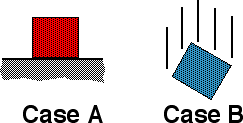Goal: Problem solving and developing strategic knowledge
Source: UMPERG-ctqpe103
You are given this problem:
A
block sits on a frictionless incline. Given the angle of incline, the
distance along the incline, and that the block is initially at rest,
find the speed after traveling a distance d.
What principle would you use to solve the problem MOST EFFICIENTLY?
- Kinematics only
- F = ma or Newton’s laws
- Work-Energy theorem
- Impulse-Momentum theorem
- Angular Impulse-Angular Momentum
- 1 and 2
- 1 and 3
- 2 and 3
- None of the above
- Not enough information given






Commentary:
Answer
(3) The change in gravitational potential can be found directly.
Alternately, the work done by the gravitational force must be equal to
the change in kinetic energy.